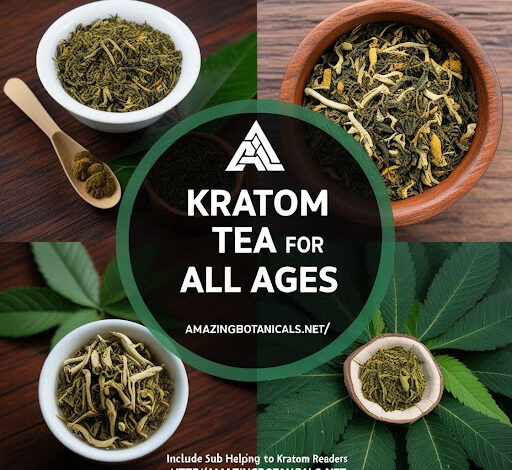The Ultimate FAQ on Kratom Tea: Answers to Your Burning Questions

Kratom tea is a drink made from the leaves of the Mitragyna speciosa tree, which grows in Southeast Asia. People have used this plant for hundreds of years as a natural remedy. The tea can have different effects depending on how much you use and what type of kratom it’s made from. In countries like Thailand, Malaysia, and Indonesia, kratom has been used for medicine and cultural reasons for a long time.
The leaves contain special compounds called alkaloids. The main ones are mitragynine and 7-hydroxymitragynine. These interact with parts of your brain called opioid receptors. This is why kratom can make you feel different things—ranging from more awake at low doses to more relaxed at higher doses. How strong these effects are can change based on factors like the age of the tree, where it grew, and how the leaves were picked.
Key Takeaways: Kratom Tea
- Made from leaves of Mitragyna speciosa, native to Southeast Asia
- Contains alkaloids that interact with opioid receptors
- Effects range from stimulant-like to sedative-like, depending on dosage
- Preparation methods typically involve steeping in hot water
- Legal status varies by country and region
- Potential benefits include pain relief and mood enhancement
- Risks include side effects and potential for dependence
- More research is needed to fully understand long-term effects
How is Kratom Tea Prepared?
Making kratom tea is simple. Here’s how you can do it:
- Measure out your kratom powder or crushed leaves. If you’re new to kratom, start with a small amount, like 1 to 5 grams.
- Heat some water until it’s hot, but not boiling. Very hot water can reduce the potency of kratom.
- Place the kratom in the hot water and let it steep for 10–20 minutes. Some prefer to steep it for up to 30 minutes for a stronger brew.
- Strain the tea to remove plant material.
- Add honey, lemon, or other flavourings to improve the taste.
Some people make a large batch and refrigerate it for later use, typically consuming it within 2–3 days. Kratom can be bitter, so many users add sweeteners or mix it with other drinks like apple cider vinegar or citrus juice to enhance the flavour and potency.
What Are the Effects of Kratom Tea?
The effects of kratom tea vary depending on dosage, strain, and individual factors like weight and metabolism. Generally, you might experience:
- Low doses: Increased energy, focus, and alertness
- Moderate doses: Euphoria, relaxation, and mild pain relief
- High doses: Sedation, strong pain relief, and drowsiness
It’s important to start with a small amount and gradually adjust to find what works best for you. Effects typically begin 15–30 minutes after consumption, peak within 1–2 hours, and last 2–5 hours.
Are There Any Risks or Side Effects?
While many people enjoy kratom tea, it’s essential to understand its potential risks. Common side effects include:
- Nausea or constipation
- Dry mouth
- Frequent urination
- Appetite suppression
- Dizziness or drowsiness (especially at high doses)
- Potential interactions with medications
Long-term or heavy use of kratom may lead to more severe risks such as liver issues, dependency, or withdrawal symptoms. If you experience adverse effects, discontinue use and consult a healthcare professional.
Is Kratom Tea Legal?
The legal status of kratom varies widely:
- United States: Legal in most states, though banned in some (e.g., Alabama, Arkansas, Indiana).
- United Kingdom: Illegal under the Psychoactive Substances Act 2016.
- Other countries: Banned in Australia, Malaysia, and some European nations but legal in Canada and parts of South America.
Always check your local regulations before purchasing or using kratom.
How Does Kratom Tea Compare to Other Forms of Kratom?
Kratom tea is one of many ways to consume this plant. Other popular methods include:
- Capsules: Convenient and tasteless.
- Powder mixed with drinks: Quick but bitter.
- Extracts: Potent but require careful dosing.
- Gummies: Flavorful and consistent.
- Tinctures: Concentrated liquid form.
- Crushed leaf: Used for tea or sometimes smoked (not recommended).
Each method has its pros and cons, depending on individual preferences and needs.
Can Kratom Tea Help with Pain?
Some users report pain relief from kratom tea, especially for chronic conditions like arthritis or fibromyalgia. Alkaloids such as mitragynine and 7-hydroxymitragynine may help reduce pain by interacting with opioid receptors.
However, kratom is not approved for medical use, and more research is needed to confirm its safety and effectiveness. Always consult a healthcare professional before using kratom gummies for pain management.
How Long Do the Effects of Kratom Tea Last?
Typically, kratom tea’s effects last 2–5 hours, though this varies based on factors like dosage, metabolism, and whether you’ve eaten recently. Regular users may build a tolerance, requiring higher doses over time.
Can Kratom Tea Be Addictive?
Kratom can be addictive if used excessively. Symptoms of withdrawal may include:
- Irritability and anxiety
- Sleep disturbances
- Muscle aches
- Digestive issues
To minimise risks, use kratom sparingly, take regular breaks, and seek professional help if you suspect dependency.
How Does Kratom Tea Mix with Other Substances?
Kratom can interact negatively with:
- Painkillers: Risk of respiratory depression.
- Sedatives: Increased drowsiness and potential breathing issues.
- Alcohol: Amplified sedation and health risks.
- Stimulants: Heightened side effects.
- Antidepressants: Possible dangerous interactions.
- Blood thinners: Altered clotting.
Always consult a doctor before combining kratom with medications or other substances.
Conclusion
Kratom tea offers a versatile way to explore the benefits of this plant, but it comes with risks and legal considerations. Always use it responsibly, start with low doses, and consult a healthcare professional if in doubt. Remember, research on kratom is ongoing, and its long-term effects are not yet fully understood.






